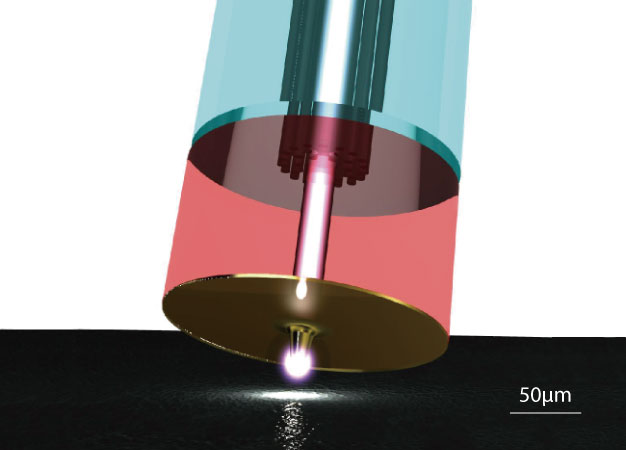Nanoscale thermometer takes precise heat readings of tiny spots, billionths of a meter wide
Published online 26 April 2017

An optical fiber, its core tapered to an aperture just 70 nanometers wide, shines light onto fluorescent quantum dots to measure their temperature.
Reproduced from Ref. 1 and licensed under CC BY 4.0 © 2017 D. Seto et al.
The temperature of tiny structures, thousands of times smaller than a grain of sand, can now be measured accurately, thanks to a technique developed by Keio University researchers1. The method could help to design more efficient electronic components, or monitor the behavior of individual cells.
The technique is a form of nanoscale thermometry, able to measure the temperature at a point just billionths of a meter wide, and it avoids some key problems of previous approaches. Scanning thermal microscopy techniques, which come in direct contact with a sample, have a spatial precision of less than 100 nanometers. But the microscope's probe tip can damage the sample, and heat exchange between the sample and the equipment can affect the temperature measurement. Meanwhile, non-contact methods using lasers have a spatial resolution that is usually limited to half the wavelength of the incoming light, which is typically several hundred nanometers.
Yoshihiro Taguchi of Keio University, and colleagues, have invented a non-contact technique called fluorescence near-field optics thermal nanoscopy (Fluor-NOTN), with a spatial resolution of just 70 nanometers. It relies on nanoscale-sized 'quantum dots' made of cadmium selenide, which fluoresce when light shines on them. Crucially, the time it takes for this fluorescence to fade away depends on the quantum dots' temperature.
The team coated a silicon surface with the quantum dots, and used a conventional electrical thermometer to monitor its temperature. They shot incredibly brief pulses of blue laser light at the surface through a specially modified optical fiber, its core tapered to a 70-nanometer-wide opening.
The pulses made the quantum dots fluoresce red light, which travelled back up the optical fiber to a detector. This showed that the fluorescence lifetime was just over 13 nanoseconds at room temperature. But as the temperature increased to 40 degrees Celsius, the lifetime decreased to about 12 nanoseconds.
By measuring the fluorescence lifetime of quantum dots in this way, the researchers hope to study the temperature distribution in minuscule straw-like structures called carbon nanotubes (CNTs). An electrical current causes some CNTs to heat up and emit light, which could be used to generate pulses that carry information in novel forms of computer chips. "Understanding the local temperature distribution is important for controlling the response speed of light emission, and the light spectrum," says Taguchi.
The researchers also aim to study living cells with Fluor-NOTN. "The temperature distribution of a cell is still unknown," says Taguchi. "We aim to map the local temperature of a single cell, such as a neuron."
Reference
- Seto, D., Nikka, R., Nishio, S., Taguchi, Y., Saiki, T. & Nagasaka, Y. Nanoscale optical thermometry using a time-correlated single-photon counting in an illumination-collection mode. Applied Physics Letters 110, 033109 (2017). | article